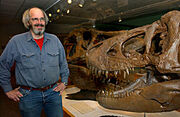 | |
|
Born |
|
|
Residence |
Bozeman, Montana |
|
Citizenship |
United States |
|
Fields |
|
|
Institutions |
|
|
Alma mater |
University of Montana |
John "Jack" R. Horner (born June 15, 1946) is an American paleontologist who discovered and named Maiasaura, providing the first clear evidence that some dinosaurs cared for their young. He is one of the best-known paleontologists in the United States. In addition to his many paleontological discoveries, Horner served as the technical advisor for all of the Jurassic Park films, and even served as partial inspiration for the movie's lead character, Dr. Alan Grant.
In Montana during the mid-1970s, Horner and his research partner Bob Makela discovered a colonial nesting site of a new dinosaur genus which they named Maiasaura, or "Good Mother Lizard". It contained the first dinosaur eggs in the Western hemisphere, the first dinosaur embryos, and settled questions of whether some dinosaurs were sociable, built nests and cared for their young. The discovery established his career. Horner has named several other species of dinosaur (including Orodromeus makelai in memory of his late friend Bob Makela) and has had two named after him: Achelousaurus horneri and Anasazisaurus horneri.
Within the paleontological community, Horner is best known for his work on the cutting edge of dinosaur growth research. He has published numerous articles in collaboration with Berkeley evolutionary biologist Kevin Padian, and French dinosaur histologist Armand Ricqlés, on the growth of dinosaurs using growth series. This usually involves leg bones in graduated sizes from different individuals ranging in age from embryos to adults. He also revitalized the contested theory that Tyrannosaurus rex was an obligate scavenger, rather than a predatory killer. This theory has been adopted by the popular press but has never been a major research focus for Dr. Horner. In 2000, Horner's crews discovered five specimens of T. rex and three more the following summer, including one even larger than the other specimens nicknamed "Sue". The specimen was 10–13 tons in weight and was 10% larger than other specimens.[1] The Museum of the Rockies, as the result of continuing fieldwork, now boasts the largest Tyrannosaurus rex collection in the world. Currently, he is working on the developmental biology of dinosaurs.[2]
History[]

Jack Horner with a cast of the B. rex skull found in eastern Montana.
Horner was born and raised in Shelby, Montana, and attended the University of Montana for seven years, majoring in geology and zoology. He also spent two years in the U.S. Marine Corps, serving during the Vietnam War in the Special Forces. Horner did not complete his bachelor's degree, due to his inability to pass required foreign language courses (he is somewhat dyslexic and could not read adequately in German). However, he did complete a formidable senior thesis on the fauna of the Bear Gulch Limestone in Montana, which is one of the most famous Mississippian lagerstätten (or exceptionally preserved fossil site) in the world. The University of Montana awarded him an Honorary Doctorate of Science in 1986. In 1986, he was also awarded the prestigious MacArthur Fellowship.
Horner has published more than 100 professional papers, six popular books including Dinosaurs Under the Big Sky (ISBN 0-87842-445-8), a non-fiction book on dinosaurs from Montana, Dinosaur Lives (ISBN 0060174862) and numerous published articles. He was also a part of the 2005 discovery of soft tissue inside of a T. rex fossil. Currently, he is the Curator of Paleontology at the Museum of the Rockies, the Regent’s Professor of Paleontology, adjunct curator at the National Museum of Natural History, and teaches with the Honors Program at Montana State University in Bozeman, Montana. Over the years he has advised those who have gone on to be the leading paleontologists of a new generation such as Greg Erickson, Scott Sampson, Kristi Curry-Rogers, and David J. Varricchio. Horner was awarded an honorary doctorate by Pennsylvania State University in 2006 in recognition of his work.
In 2003 Horner discovered a fossilized Tyrannosaurus leg bone from which paleontologist Mary Higby Schweitzer was able to retrieve proteins in 2007.[1]
His latest book, How to Build a Dinosaur: Extinction Doesn't Have to Be Forever (ISBN 978-0-525-95104-9), was published in 2009.
References[]
External links[]
- Museum of the Rockies Paleontology homepage
- Jacqui Hayes: Large flock of parrot-like dinosaurs uncovered COSMOS magazine
- [3]